
Protocarnivorous plant
Encyclopedia
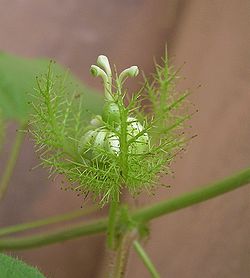
Insect
Insects are a class of living creatures within the arthropods that have a chitinous exoskeleton, a three-part body , three pairs of jointed legs, compound eyes, and two antennae...
s or other animal
Animal
Animals are a major group of multicellular, eukaryotic organisms of the kingdom Animalia or Metazoa. Their body plan eventually becomes fixed as they develop, although some undergo a process of metamorphosis later on in their life. Most animals are motile, meaning they can move spontaneously and...
s but lacks the ability to either directly digest
Digestion
Digestion is the mechanical and chemical breakdown of food into smaller components that are more easily absorbed into a blood stream, for instance. Digestion is a form of catabolism: a breakdown of large food molecules to smaller ones....
or absorb nutrients from its prey like a carnivorous plant
Carnivorous plant
Carnivorous plants are plants that derive some or most of their nutrients from trapping and consuming animals or protozoans, typically insects and other arthropods. Carnivorous plants appear adapted to grow in places where the soil is thin or poor in nutrients, especially nitrogen, such as acidic...
. The morphological
Morphology (biology)
In biology, morphology is a branch of bioscience dealing with the study of the form and structure of organisms and their specific structural features....
adaptations such as sticky trichome
Trichome
Trichomes are fine outgrowths or appendages on plants and certain protists. These are of diverse structure and function. Examples are hairs, glandular hairs, scales, and papillae.- Algal trichomes :...
s or pitfall traps of protocarnivorous plants parallel the trap structures of confirmed carnivorous plants.
Some authors prefer the term "protocarnivorous" because it implies that these plants are on the evolution
Evolution
Evolution is any change across successive generations in the heritable characteristics of biological populations. Evolutionary processes give rise to diversity at every level of biological organisation, including species, individual organisms and molecules such as DNA and proteins.Life on Earth...
ary path to true carnivory, while others oppose the term for the same reason. The same problem arises with "subcarnivorous." Donald Schnell, author of the book Carnivorous Plants of the United States and Canada, prefers the term "paracarnivorous" for a less rigid definition of carnivory that can include many of the possible carnivorous plants.
The demarcation between carnivorous and protocarnivorous is blurred by the lack of a strict definition of botanical carnivory and ambiguous academic literature on the subject. Many examples of protocarnivorous plants exist, some of which are counted among the ranks of true carnivorous plants as a matter of historical preference. Further research into these plants' carnivorous adaptations may reveal that a few protocarnivorous plants do meet the more rigid definition of a carnivorous plant.
Historical observations

Charles Darwin
Charles Robert Darwin FRS was an English naturalist. He established that all species of life have descended over time from common ancestry, and proposed the scientific theory that this branching pattern of evolution resulted from a process that he called natural selection.He published his theory...
had suggested many plants that have developed adhesive glands, such as Erica tetralix
Erica tetralix
Erica tetralix is a species of heather found in Atlantic areas of Europe, from southern Portugal to central Norway, as well as a number of boggy regions further from the coast in Central Europe. In bogs, wet heaths and damp coniferous woodland, Erica tetralix can become a dominant part of the flora...
, Mirabilis longifolia, Pelargonium zonale, Primula sinesis, and Saxifraga umbrosa, may indeed be carnivorous but little research has been done on them. Darwin himself only mentioned these species in passing and did not follow through with any investigation. Adding to the small but growing list, Francis Lloyd provided his own list of species suspected of carnivory in his 1942 book on carnivorous plants, though these species and their potential were only mentioned in the introduction. Later, in a 1981 review of the literature, Paul Simons rediscovered Italian journal articles from the early 1900s that identified several additional sticky species that digested insect prey. Simons was surprised to find these articles lacking in the literature cited sections of many modern books and articles on carnivorous plants, suggesting that academic research has treated Lloyd's 1942 book as the authoritative and comprehensive source on pre-1942 research on the carnivorous syndrome.
Defining carnivory
Debate about what criteria a plant must meet to be considered carnivorous has yielded two proposed definitions: one with strict requirements and the other less restrictive.
Brocchinia reducta
Brocchinia reducta is one of few carnivorous bromeliads. It is native to southern Venezuela, Brazil and Guyana, and is found in nutrient-poor soil....
or downward facing hairs of Heliamphora
Heliamphora
The genus Heliamphora contains 23 species of pitcher plants endemic to South America. The species are collectively known as sun pitchers, based on the mistaken notion that the heli of Heliamphora is from the Greek helios, meaning "sun"...
prevent escape), digest the dead prey through enzymes produced by the plant, and absorb the products of digestion through specialized structures. The presence of commensals
Commensalism
In ecology, commensalism is a class of relationship between two organisms where one organism benefits but the other is neutral...
is also listed as strong evidence of a long evolutionary history of carnivory. By this definition, many sun pitcher plants (Heliamphora) and the cobra lily
Darlingtonia californica
Darlingtonia californica , also called the California Pitcher plant, Cobra Lily, or Cobra Plant, is a carnivorous plant, the sole member of the genus Darlingtonia in the family Sarraceniaceae. It is native to Northern California and Oregon, growing in bogs and seeps with cold running water...
(Darlingtonia californica) would not be included on a roster of carnivorous plants because they rely on symbiotic
Symbiosis
Symbiosis is close and often long-term interaction between different biological species. In 1877 Bennett used the word symbiosis to describe the mutualistic relationship in lichens...
bacteria and other organisms to produce the necessary proteolytic
Proteolysis
Proteolysis is the directed degradation of proteins by cellular enzymes called proteases or by intramolecular digestion.-Purposes:Proteolysis is used by the cell for several purposes...
enzymes.
The broader definition differs mainly in including plants that do not produce their own digestive enzymes but rely on internal food webs or microbes to digest prey, such as Darlingtonia
Darlingtonia californica
Darlingtonia californica , also called the California Pitcher plant, Cobra Lily, or Cobra Plant, is a carnivorous plant, the sole member of the genus Darlingtonia in the family Sarraceniaceae. It is native to Northern California and Oregon, growing in bogs and seeps with cold running water...
and some species of Heliamphora
Heliamphora
The genus Heliamphora contains 23 species of pitcher plants endemic to South America. The species are collectively known as sun pitchers, based on the mistaken notion that the heli of Heliamphora is from the Greek helios, meaning "sun"...
. Both the strict and broad definitions incorporate requirements for adaptations or resource allocations that result in the active attraction, capture, and/or digestion of prey. Both also require adsorption of the digested nutrients. The broader definition stipulates that the plant must receive some noticeable benefit from the carnivorous syndrome. That is, the plant must display some significant increase in fitness because of the nutrients obtained from its carnivorous adaptations (i.e. increased growth rate, increased chance of survival, higher pollen production or seed set).
Degrees of carnivory

Phototroph
Phototrophs are the organisms that carry out photosynthesis to acquire energy. They use the energy from sunlight to convert carbon dioxide and water into organic material to be utilized in cellular functions such as biosynthesis and respiration.Most phototrophs are autotrophs, also known as...
(a rose
Rose
A rose is a woody perennial of the genus Rosa, within the family Rosaceae. There are over 100 species. They form a group of erect shrubs, and climbing or trailing plants, with stems that are often armed with sharp prickles. Flowers are large and showy, in colours ranging from white through yellows...
, for example) to fully carnivorous plants with active trapping mechanisms like those of Dionaea or Aldrovanda
Aldrovanda
Aldrovanda is a genus of carnivorous plants encompassing one extant species and numerous extinct taxa. The genus is named in honor of the Italian naturalist Ulisse Aldrovandi, the founder of the Botanical Garden of Bologna, Orto Botanico dell'Università di Bologna.The extinct species are known...
. Plants that fall between the definitions in the strict carnivorous/non-carnivorous demarcation can be defined as being protocarnivorous.
It is thought that these plants that have evolved protocarnivorous habits typically reside in habitats where there is a significant nutrient deficiency, but not the severe deficiency in nitrogen
Nitrogen
Nitrogen is a chemical element that has the symbol N, atomic number of 7 and atomic mass 14.00674 u. Elemental nitrogen is a colorless, odorless, tasteless, and mostly inert diatomic gas at standard conditions, constituting 78.08% by volume of Earth's atmosphere...
and phosphorus
Phosphorus
Phosphorus is the chemical element that has the symbol P and atomic number 15. A multivalent nonmetal of the nitrogen group, phosphorus as a mineral is almost always present in its maximally oxidized state, as inorganic phosphate rocks...
seen where true carnivorous plants grow. The function of the protocarnivorous habit, however, need not be directly related to lack of nutrient access. Some classic protocarnivorous plants represent convergent evolution
Convergent evolution
Convergent evolution describes the acquisition of the same biological trait in unrelated lineages.The wing is a classic example of convergent evolution in action. Although their last common ancestor did not have wings, both birds and bats do, and are capable of powered flight. The wings are...
in form but not necessarily in function. Plumbago, for example, possesses glandular trichomes on its calyces
Sepal
A sepal is a part of the flower of angiosperms . Collectively the sepals form the calyx, which is the outermost whorl of parts that form a flower. Usually green, sepals have the typical function of protecting the petals when the flower is in bud...
that structurally resemble the tentacles of Drosera and Drosophyllum
Drosophyllum
Drosophyllum is a genus of carnivorous plants containing the single species Drosophyllum lusitanicum...
. The function of the Plumbago tentacles is, however, disputed. Some contend that their function is to aid in pollination
Pollination
Pollination is the process by which pollen is transferred in plants, thereby enabling fertilisation and sexual reproduction. Pollen grains transport the male gametes to where the female gamete are contained within the carpel; in gymnosperms the pollen is directly applied to the ovule itself...
, adhering seeds to visiting pollinators. Others note that on some species (Plumbago auriculata
Plumbago auriculata
Plumbago auriculata, also called Plumbago capensis, Blue plumbago, Cape plumbago or Cape leadwort, is a well known houseplant originally from South Africa....
), small, crawling insects have been trapped in the Plumbago
Trapping mechanisms
There are visible parallels between the trapping mechanisms of carnivorous plants and protocarnivorous plants. PlumbagoPlumbago
Plumbago is a genus of 10-20 species of flowering plants in the family Plumbaginaceae, native to warm temperate to tropical regions of the world. Common names include plumbago and leadwort...
and other species with glandular trichomes resemble the flypaper traps of Drosera and Drosophyllum. The pitfall traps of protocarnivorous plants, such as some Heliamphora species and Darlingtonia californica, are so similar to those of true carnivorous plants that the only reason they may be considered protocarnivorous instead of carnivorous is that they do not produce their own digestive enzymes. There are also protocarnivorous bromeliads that form a pitfall trap in an "urn" of rosetted
Rosette (botany)
In botany, a rosette is a circular arrangement of leaves, with all the leaves at a single height.Though rosettes usually sit near the soil, their structure is an example of a modified stem.-Function:...
leaves that are held together tightly. There are also other plants that produce a sticky mucilage not necessarily associated with a tentacle or glandular trichome, but instead can be described more like a slime capable of trapping and killing insects.
Flypaper traps
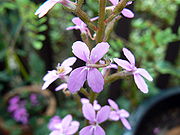
University of Idaho
The University of Idaho is the State of Idaho's flagship and oldest public university, located in the rural city of Moscow in Latah County in the northern portion of the state...
has discovered protocarnivorous activity and function in several glandular plant species, including Cerastium arvense
Cerastium arvense
Cerastium arvense is a species of flowering plant in the pink family known by the common name field chickweed. It is a widespread species, occurring throughout Europe and North America, as well as parts of South America. It is a variable species. There are several subspecies, but the number and...
, Ipomopsis aggregata, Heuchera cylindrica, Mimulus lewisii
Mimulus lewisii
Mimulus lewisii is a perennial plant in the family Phrymaceae. It is named in honor of Meriwether Lewis...
, Penstemon attenuata, Penstemon diphyllus, Potentilla glandulosa
Potentilla glandulosa
Potentilla glandulosa is a species of cinquefoil known by the common name sticky cinquefoil. It is native to western North America from southwestern Canada to the southwestern United States, where it is widespread and can be found in many types of habitat. It is highly variable and there are many...
var. intermedia, Ribes cereum
Ribes cereum
Ribes cereum is a species of currant known by the common names wax currant and squaw currant...
, Rosa nutkana var. hispida, Rosa woodsii
Rosa woodsii
Rosa woodsii is a species of rose known by the common name Woods' rose. It is native to North America including much of Canada and Alaska and the western and central United States. It grows in a variety of habitat types, including disturbed areas....
var. ultramontana, Solanum tuberosum, Stellaria americana, and Stellaria jamesiana. These species tested positive for protease
Protease
A protease is any enzyme that conducts proteolysis, that is, begins protein catabolism by hydrolysis of the peptide bonds that link amino acids together in the polypeptide chain forming the protein....
activity, though it is unclear whether the protease is produced by the plant or by surface microbes. Two other species evaluated by Dr. Spomer, Geranium viscosissimum
Geranium viscosissimum
Geranium viscosissimum, commonly known as the sticky purple geranium, is a perennial in the Geraniaceae family of flowering plants. It is thought to be a protocarnivorous plant.-Carnivory:In his 1999 journal article, G.G...
and Potentilla arguta
Potentilla arguta
Drymocallis arguta, commonly known as the tall cinquefoil or sticky cinquefoil, is a perennial plant in the Rosaceae family of flowering plants native to North America. It was formerly included with the typical cinquefoils in the genus Potentilla.There are two accepted subspecies:* Drymocallis...
, exhibited protease activity and were further examined with 14C
Carbon-14
Carbon-14, 14C, or radiocarbon, is a radioactive isotope of carbon with a nucleus containing 6 protons and 8 neutrons. Its presence in organic materials is the basis of the radiocarbon dating method pioneered by Willard Libby and colleagues , to date archaeological, geological, and hydrogeological...
-labeled algal protein for nutrient absorption activity. Both of these latter species displayed an ability to digest and absorb the labeled protein.
Other plants that are considered to be protocarnivorous have sticky trichomes on some surface, such as the flower scape
Scape (botany)
In botany, scapes are leafless flowering stems that rise from the ground. Scapes can have a single flower or many flowers, depending on the species....
and bud of Stylidium and Plumbago
Plumbago
Plumbago is a genus of 10-20 species of flowering plants in the family Plumbaginaceae, native to warm temperate to tropical regions of the world. Common names include plumbago and leadwort...
, the bract
Bract
In botany, a bract is a modified or specialized leaf, especially one associated with a reproductive structure such as a flower, inflorescence axis, or cone scale. Bracts are often different from foliage leaves. They may be smaller, larger, or of a different color, shape, or texture...
s of Passiflora foetida
Passiflora foetida
Passiflora foetida is a species of passion flower that is native to the southwestern United States , Mexico, the Caribbean, Central America, and much of South America...
, and leaves of Roridula
Roridula
Roridula is a South African genus of plants that, whilst having many of the adaptations of a carnivorous plant, such as the possession of insect-trapping sticky hairs, does not directly digest the animals it traps. Instead, it has a mutualistic relationship with Pameridea roridulae, a species of...
. The trichomes of Stylidium, which appear below the flower, have been known to trap and kill small insects since their discovery several centuries ago, but their purpose remained ambiguous. In November 2006, Dr. Douglas Darnowski published a paper describing the active digestion of proteins when they come in contact with a trichome of a Stylidium species grown in aseptic
Aseptic technique
Aseptic technique refers to a procedure that is performed under sterile conditions. This includes medical and laboratory techniques, such as with microbiological cultures. It includes techniques like flame sterilization...
tissue culture
Plant tissue culture
Plant tissue culture is a collection of techniques used to maintain or grow plant cells, tissues or organs under sterile conditions on a nutrient culture medium of known composition. Plant tissue culture is widely used to produce clones of a plant in a method known as micropropagation...
, proving that the plant, rather than the surface microbes, was the source of protease production. Darnowski asserts in that paper that given this evidence, Stylidium species are properly called carnivorous, though in order to fulfill the strict definition of carnivory it needs to be proven that they are capable of absorbing nutrients derived from prey and that this adaptation gives the plants some competitive advantage.
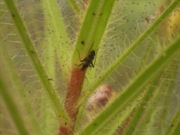
Symbiosis
Symbiosis is close and often long-term interaction between different biological species. In 1877 Bennett used the word symbiosis to describe the mutualistic relationship in lichens...
with species of assassin bugs that eat the trapped insects. The plant benefits from the nutrients in the bugs' feces
Feces
Feces, faeces, or fæces is a waste product from an animal's digestive tract expelled through the anus or cloaca during defecation.-Etymology:...
.
Likewise, the sticky, modified bracts of Passiflora foetida have been investigated for their carnivorous ability. A 1995 paper published in the Journal of Biosciences detailed the evidence that the glandular bracts played a distinct role in defense of the flower and were also capable of digesting captured prey and absorbing the nutrients.
Ibicella lutea
Ibicella lutea
Ibicella lutea |syn.]] Martynia lutea, Proboscidea lutea) is a species of flowering plant known by the common names devil's claw, unicorn plant, martynia, proboscis flower, and ram's horn. It grows in dry conditions, such as those in desert regions...
is another flypaper protocarnivore that has been the subject of several studies. Early studies concluded that the plant digested proteinaceous offerings, though the methods were crude. Subsequent studies done more carefully tested for the presence of protease activity and found none, though it was noted that the plant has a great capacity for capturing and killing prey.
Pitfall traps
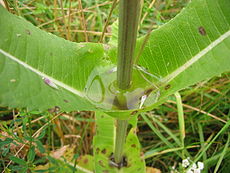
Darlingtonia californica
Darlingtonia californica , also called the California Pitcher plant, Cobra Lily, or Cobra Plant, is a carnivorous plant, the sole member of the genus Darlingtonia in the family Sarraceniaceae. It is native to Northern California and Oregon, growing in bogs and seeps with cold running water...
and several Heliamphora
Heliamphora
The genus Heliamphora contains 23 species of pitcher plants endemic to South America. The species are collectively known as sun pitchers, based on the mistaken notion that the heli of Heliamphora is from the Greek helios, meaning "sun"...
species do not produce their own enzymes, relying instead on an internal food web to break down the prey into absorbable nutrients.
Another pitfall trap form unrelated to the Sarraceniaceae
Sarraceniaceae
Sarraceniaceae is a family of pitcher plants , belonging to order Ericales .The family comprises three extant genera: Sarracenia , Darlingtonia , and Heliamphora . The extinct Archaeamphora longicervia may also belong to this family...
family are the urns of bromeliad leaves that are formed when leaves are tightly packed together in a rosette, collecting water and trapping insects. Unlike Brocchinia reducta
Brocchinia reducta
Brocchinia reducta is one of few carnivorous bromeliads. It is native to southern Venezuela, Brazil and Guyana, and is found in nutrient-poor soil....
, which has been proven to produce at least one digestive enzyme and can therefore be considered carnivorous, the epiphytic
Epiphyte
An epiphyte is a plant that grows upon another plant non-parasitically or sometimes upon some other object , derives its moisture and nutrients from the air and rain and sometimes from debris accumulating around it, and is found in the temperate zone and in the...
Catopsis berteroniana
Catopsis berteroniana
Catopsis berteroniana is an epiphytic bromeliad thought to be a possible carnivorous plant, similar to Brocchinia reducta, although the evidence is equivocal. Its native range is from southern Florida to southern Brazil. It generally grows on the unshaded twigs of trees, and appears to trap more...
has little evidence supporting the claims that it is carnivorous. It is able to attract and kill prey and the trichomes on the surface of the leaves can absorb nutrients, but so far no enzyme activity has been detected. It may be that this plant also relies on an internal food web for soft tissue digestion. The same could be said for Paepalanthus bromelioides, though it is a member of Eriocaulaceae
Eriocaulaceae
The Eriocaulaceae or pipewort family is a family of monocotyledonous flowering plants in the order Poales. The family is large, with about 1,150-1,200 species described in ten genera. The family is widely distributed, with the centers of diversity for the group occurring in tropical regions,...
and not a bromeliad. It also forms a central water reservoir that has adaptations to attract insects. It, like C. berteroniana, produces no digestive enzymes.
Another potential protocarnivorous pitfall trap is a species of teasel
Dipsacus
Dipsacus is a genus of flowering plant in the family Dipsacaceae. The members of this genus are known as teasel or teazel or teazle. The genus includes about 15 species of tall herbaceous biennial plants growing to tall...
, Dipsacus fullonum
Dipsacus fullonum
Dipsacus fullonum, syn. Dipsacus sylvestris, is a species of flowering plant known by the common names Fuller's teasel and wild teasel. It is native to Eurasia and North Africa, but it is known in the Americas, southern Africa, Australia and New Zealand as an introduced species and often a noxious...
, which has been only suggested as a possible carnivore. Only one major study has examined D. fullonum for carnivory and no evidence of digestive enzymes or foliar nutrient absorption was revealed.
Other
Capsella bursa-pastoris, shepherd's purse, is another plant where the claim of carnivory is contested. This unique protocarnivorous plant is only capable of capturing prey during one stage of its life cycle. The seeds of the plant, when moistened, secrete a viscous fluid that actively attracts and kills prey. There is also evidence of protease activity and absorption of nutrients. The only carnivory criterion not explored is how much the plant benefits from the carnivorous adaptation.Loss of carnivory
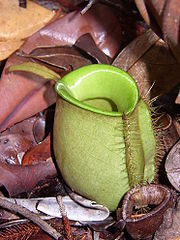
Nepenthes ampullaria
Nepenthes ampullaria , the Flask-Shaped Pitcher-Plant, is a very distinctive and widespread species of Nepenthes, present in Borneo, Sumatra, Thailand, Peninsular Malaysia, Singapore, the Maluku Islands, and New Guinea...
, a tropical pitcher plant. While it retains its ability to attract, capture, kill, and digest insect prey, this species has acquired adaptations that appear to favor digestion of leaf litter. It could potentially be referred to as a detritivore
Detritivore
Detritivores, also known as detritophages or detritus feeders or detritus eaters or saprophages, are heterotrophs that obtain nutrients by consuming detritus . By doing so, they contribute to decomposition and the nutrient cycles...
. Another tropical pitcher plant, Nepenthes lowii
Nepenthes lowii
Nepenthes lowii , or Low's Pitcher-Plant, is a tropical pitcher plant endemic to Borneo. It is named after Hugh Low, who discovered it on Mount Kinabalu...
, is known to catch very few prey items compared to other Nepenthes. Preliminary observations suggest that this particular species may have moved away from a solely (or even primarily) carnivorous nature and be adapted to "catching" the droppings of birds feeding at its nectaries. A 2009 study found that mature N. lowii plants derived 57–100% of their foliar nitrogen from tree shrew droppings.
Utricularia purpurea
Utricularia purpurea
Utricularia purpurea, the eastern purple bladderwort, is a medium-sized suspended aquatic carnivorous plant that belongs to the genus Utricularia. U. purpurea is endemic to North and Central America. It has been suggested that U. purpurea may have partially lost its appetite for carnivory...
, a bladderwort, comes from another genus of carnivorous plants and may have lost its appetite for carnivory, at least in part. This species can still trap and digest arthropod prey in its specialized bladder traps, but does so sparingly. Instead, it harbors a community of algae, zooplankton, and debris in the bladders, giving rise to the hypothesis that the bladders of U. purpurea favor a mutualistic interaction in place of a predator-prey relationship.
Evolution
The disciplines of ecology and evolutionary biology have presented several hypotheses on the evolution of carnivorous plants that may also apply to protocarnivorous plants. The name "protocarnivorous plant" itself suggests that these species are on their way to carnivory, though others may simply be an example of a defense-related adaptation, such as that found in PlumbagoPlumbago
Plumbago is a genus of 10-20 species of flowering plants in the family Plumbaginaceae, native to warm temperate to tropical regions of the world. Common names include plumbago and leadwort...
. Still others (Utricularia purpurea, Nepenthes ampullaria, and Nepenthes lowii) may be examples of carnivorous plants moving away from the carnivorous syndrome.
In his 1998 book, Interrelationship Between Insects and Plants, Pierre Jolivet only considered four species of plants to be protocarnivorous: Catopsis berteroniana, Brocchinia reducta
Brocchinia reducta
Brocchinia reducta is one of few carnivorous bromeliads. It is native to southern Venezuela, Brazil and Guyana, and is found in nutrient-poor soil....
, B. hectioides, and Paepalanthus bromeloides. Jolivet writes, "It is important to remember that all carnivorous plants are dicots and all protocarnivorous plants are monocots," though he does not explain why nor does he describe his reasons for excluding other dicotyledonous plants that are protocarnivorous.
Further reading
- Rice, B.A. (2011). What exactly is a carnivorous plant? Carnivorous Plant Newsletter, 40(1): 19–23.

